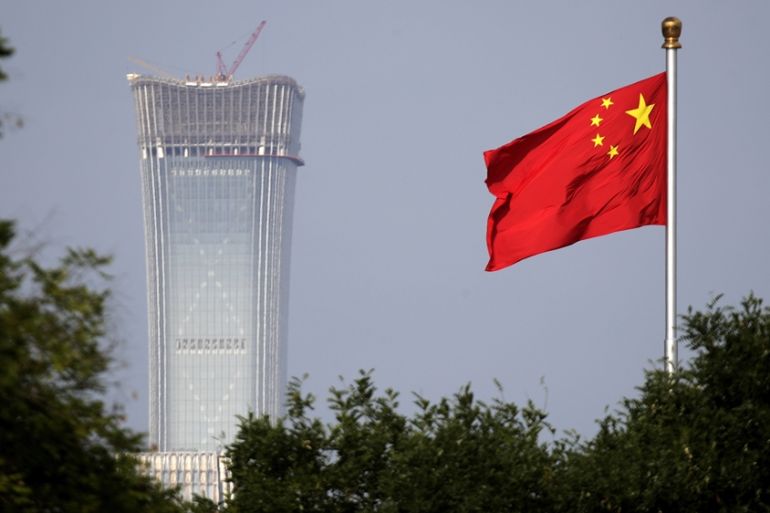China’s great slowdown: Economic growth slumps to 27-year low
Ongoing trade tensions with US and limited space for stimulus measures further dampen China’s economic outlook.

For anyone paying attention to China‘s economy of late, the news that growth fell last quarter to its slowest pace in nearly 30 years would not have come as too much of a surprise.
The trade war with the United States, slowing domestic demand for goods such as cars and a viral epidemic that has wiped out a large part of China’s pork industry have all weighed on the economy.
Keep reading
list of 4 itemsGazprom falls to first annual loss in 20 years as trade with Europe hit
Candidates confront corruption and inequality in Panama’s presidential race
What is behind the insulin shortage in the US?
But the growth rate of six percent in China’s gross domestic product (GDP) – the sum of all finished goods and services produced by the country – for the July-to-September period does underscore the depth of the problems China now faces, analysts say.
“The sustained slide from 6.8 percent from [the first quarter of] 2018 leaves no doubt that the downturn is serious,” Vishnu Varathan, head of economics and strategy at Mizuho Bank in Singapore, told Al Jazeera.
There were, however, some bright spots in the otherwise gloomy economic picture.
Factory output was up by 5.8 percent in September, while retail sales expanded by 7.8 percent and investment grew by 5.4 percent in the first nine months of 2019, according to the National Bureau of Statistics of China.
But the weaker-than-expected headline quarterly GDP figure raises the prospect of sub-par growth over the whole of 2019, said Jeff Ng, managing director at research firm Continuum Economics in Singapore.
It also begs the question as to whether the Chinese government’s GDP growth target of six to 6.5 percent for the full year can be reached, he told Al Jazeera.
That target now appears to be slipping further away from China’s policymakers, as the US-China trade war drags on with no firm agreement on the table as yet, despite US trade representatives expressing hopes that a deal can be signed by the countries’ leaders next month.
But could the weak third-quarter data force Beijing’s hand into signing a deal quicker than they would have otherwise liked? Many analysts say that is unlikely.
“The latest numbers are not likely to have much impact on the trade negotiations with the US,” said Ross O’Brien, principal analyst at consultancy firm Intercedent in Hong Kong.
He said that China is less fixated on top-line growth than the US is, and has for years signalled its intentions to manage a slowdown. Beijing has been trying to curb excessive lending in unproductive areas of the economy that have resulted in dangerously high prices of assets such as property in some parts of the country.
“All this predates the trade war,” O’Brien told Al Jazeera.
Still, the uncertainty surrounding trade tensions is likely to continue affecting business decisions, which could further dampen economic prospects for China and its neighbours.
Continuum’s Ng noted that any dampening of growth in China has “always shown an adverse effect on most Asian economies.”
“Unchecked, the US-China trade conflict is set to sink growth [in China] well below 6 percent, very quickly,” Mizuho’s Varathan said.
Limited policy measures available
Officials have focused their attempts to boost growth on limited measures, such as encouraging commercial banks to lend more by reducing the amount of excess reserves they have to maintain with the central bank. And the central bank has been trying to increase lending to small firms.
But they have appeared wary of expanding the nation’s already heavy debt load.
Ng doubts there will be any “big-ticket spending” by China’s government, although it may continue to execute smaller stimulus measures.
Varathan says Beijing will also be reluctant to use stimulus measures such as a drastic devaluation of its currency to boost exports. Doing so could encourage investors to take their money out of China and antagonise the US during the delicately poised trade negotiations.
“Underlying financial risks constrain ability to fire up full-fledged credit-driven growth,” he said.
The likelihood, therefore, of China taking any bold steps to ramp up growth is unlikely.
“China has been anticipating slower growth for years, and has been carefully managing a gradual slowdown as its economy, which is still growing fast and nearly twice the global average, matures and transitions to one driven by domestic consumption and not exports,” O’Brien said.